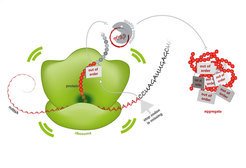 In order to be able to treat neurodegenerative disorders in future, researcher Ulrich Hartl, Head of the Department of Cellular Biochemistry at the Max Planck Institute of Biochemistry, and his team have for many years been studying the cellular causes for the death of nerve cells. A determining cause is believed to be protein deposits — aggregates of misfolded proteins. «We were able to show that the formation of aggregates is promoted by defects in the protein blueprint and these are not detected by the internal quality control machinery», explains
In order to be able to treat neurodegenerative disorders in future, researcher Ulrich Hartl, Head of the Department of Cellular Biochemistry at the Max Planck Institute of Biochemistry, and his team have for many years been studying the cellular causes for the death of nerve cells. A determining cause is believed to be protein deposits — aggregates of misfolded proteins. «We were able to show that the formation of aggregates is promoted by defects in the protein blueprint and these are not detected by the internal quality control machinery», explains
In each cell, proteins perform vital functions, acting as small molecular machines. «DNA can be envisaged as a huge library of protein blueprints that are located in the cell nucleus. To manufacture a protein, a copy of the blueprint, the mRNA, is first made. This is then directed from the cell nucleus to the ribosomes, which then build the protein from amino acids», says Choe.
Essential stop signal
The mRNA contains a start signal, the information about the protein structure, a stop signal and, at the end, a poly(A) tail. If the blueprint is damaged, for example due to radiation or mutagenic substances, this can lead to the loss of this stop signal. As a result, once the protein has been manufactured in the ribosomes, the completed protein cannot be released. Instead, the poly(A) tail is interpreted as the blueprint and additional amino acids are attached. The lysine chain that is positively charged as a result blocks the protein factory and the manufacture of protein comes to a standstill.
Healthy cells have a very efficient quality control process when it comes to the manufacture of protein. Misfolded and useless proteins are selected, repaired or rapidly destroyed. Ltn1p is an important component of quality control. «If Ltn1p is not active in pathologically modified cells or if other components of quality control are missing, defective proteins accumulate and form aggregates in cell interiors», says Park.
Using a mouse model, the researchers can now demonstrate the fatal consequences of a quality control malfunction. Animals with the relevant mutation show symptoms of advanced neurodegeneration and a restricted ability to move.
Sticky clumps
The protein aggregates that develop have a sticky surface and act as a seed. They ultimately also bind functioning proteins, which are free of defects and vital for the cell. As a result, the cell is destabilized and, in the long run, is damaged. Interestingly, according to Ulrich Hartl, the cell seems to follow a known pattern in this regard. «We already know from previous studies on the protein huntingtin, which spontaneously forms aggregates and is responsible for the development of the neurodegenerative disorder Huntington’s disease, that protein aggregates also bind to essential proteins that have no defects.»
«Our results not only demonstrate a potential mechanism for the development of


